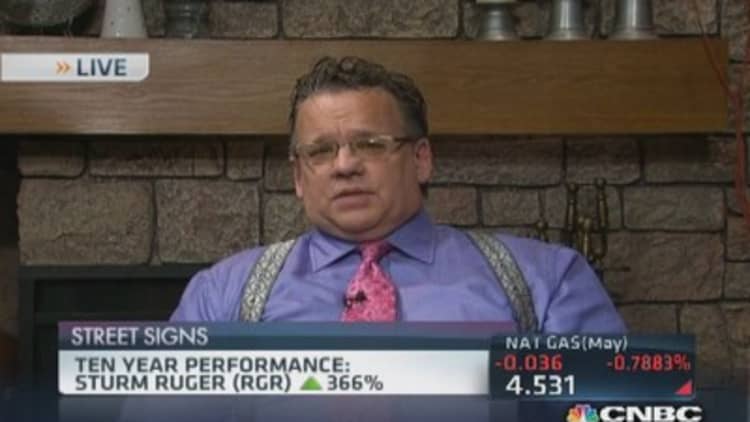
After recent attempts at gun control spurred unprecedented sales, firearms makers may be facing a new challenge: overcrowded gun racks. That may spell trouble for some companies but others are drawing younger and female buyers brought in by a recent buying frenzy.
As CNBC has reported, gun sales spiked with the re-election of President Barack Obama—who this week again expressed his wish for stronger gun control laws. Yet, industry figures show a recent decline in sales. Analysis from KeyBanc estimates a 9.9 percent year-over-year sales decline from May, based on an adjusted calculation of the monthly National Instant Criminal Background Check System data.
Some analysts point to this as evidence that enthusiasts' fears of an impending federal ban on certain firearms have been allayed, but it may simply be an issue of a durable good realizing increased market saturation.
Read More The Sandy Hook effect: Gun sales rise as stocks fall
"Clearly the biggest reason for the slowdown in demand is that previous years' sales were driven by fear of reform, and consumers are starting to realize this is most likely not going to be the case," Maksim Soshkin, an industry analyst with research firm IBISWorld, said. "But also a lot of the existing demand has been satisfied over the past couple of years, so consumers won't be spending as much."
The slowdown will affect companies in different ways, analysts said, with more nimble stalwarts such as Smith & Wesson weathering the decline better than others.
Eight of nine analysts who follow Smith & Wesson rate it as a "buy" according to FactSet, while competitor Sturm, Ruger & Co is much more mixed with an average rating of "hold." The lone negative analyst on Smith & Wesson, Keybanc's Scott Hamann, wrote in a recent report that he expects many in the industry to suffer in light of the decreasing demand. This change may, however, present an opportunity for the strongest companies to separate from the rest of the pack.
"The surge was so strong that everybody was selling everything off the shelves. Virtually nobody in the industry had a bad year last year," Wedbush analyst Rommel Dionisio said, adding that this year has seen Smith & Wesson (in which he maintains an outperform rating) and privately held Kahr Arms taking market share as their product offerings differentiate them from the competition.
Read More How do you boost GDP? Women and guns
Freedom Group—a manufacturer owned by Cerberus Capital Management that produces iconic brands such as Remington Arms and Bushmaster—saw first-quarter sales decline about 20 percent compared with the previous year, according to Soshkin. That said, last year "was probably the best year they ever had," Dionisio explained, adding that most companies were forward thinking enough to know that a demand surge was unsustainable.
But despite a return to more normal sales levels, the face of the industry may have been permanently altered by the Obama gun boost.

"We've seen the rise of a lot of enthusiasts, and people are getting younger that buy guns," Soshkin said, adding that recreational shooting at firing ranges has overtaken hunting as the No. 1 reason people are buying AR-style rifles.
Women are also increasingly driving demand for firearms, with IBISWorld explaining in a February report that they are buying for safety and recreational reasons. That demand trend may have been boosted by the buying fervor after the Sandy Hook shootings, but it has been spurred by an increasing amount of states adopting concealed carry laws, Dionisio said.
Full gun racks and an altered consumer base are also changing what companies are successfully selling. Sturm, Ruger & Co saw sales increase 9 percent last quarter, and much of that was due to a boost in accessories, Soshkin said.
Read More Remington under fire: A CNBC investigation
"With all these guns out there, people are starting to buy more accessories," he said. "And those accessory sales are going to help [firearms manufacturers] stabilize with the changes in demand."
As for the future health of the industry, opinion varies. KeyBanc's Hamann wrote in a March note on Smith & Wesson that he expects the industry-leading company to face a "worrisome setup" in the face of demand that continues to be "materially moderate." Wedbush's Dionisio, on the other hand, said he sees continued strong growth throughout much of the category.
Smith & Wesson reports earnings results Thursday, June 19.
—By CNBC's Everett Rosenfeld


